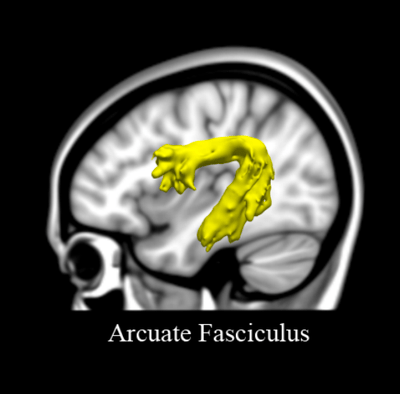Advertisement
Tracking Dyslexia In The Preschool Brain
Guest Contributor
Roughly one child in 10 will struggle to learn to read, but no one can tell which one until he or she starts to fall seriously behind.
At that point – often in 3rd grade – they’ve already taken a hit to their self-esteem and they’re too old for early intervention that can make the biggest difference.
This conundrum has troubled MIT professor John Gabrieli for years.

Today, the neuroscientist and colleagues published a study that begins to address the problem. They showed on brain scans that kindergartners at risk for dyslexia also had less robust connections between two key language areas on the left side of the brain.
Previously, researchers weren’t sure whether the differences they saw in the brains of people with dyslexia were causes of the condition, or effects of their struggle to read. Because Gabrieli’s group saw the distinction in children too young to read, their brain differences must predate reading problems.
His ultimate hope, of course, is to use these differences to identify children before they begin to struggle, and get them into early intervention programs.
It’s too soon to tell whether the less robust nerve connections he saw can be used to diagnose dyslexia. Gabrieli said he needs to wait a few more years to see if the kids who looked to be high risk on the brain scan turn out to have dyslexia.
Dyslexia is defined as a reading challenge not explained by obvious problems like poor vision. Reading is generally hard for these kids because they have trouble distinguishing between the simplest sounds, known as phonemes. Most early readers will be able to rapidly put sounds like “mm,” “ah,” and “t” together into the word “mat.”
Dyslexics have more trouble manipulating the sounds of language so they can match them up to the printed text, Gabrieli said. This means they take much longer to learn reading than most people, and may always do it more slowly.
But there is a wide range of “normal” in learning to read, so, while it’s easy to recognize children with the worst reading troubles, many more slip through the cracks, Gabrieli said. “The problem has been having a measure that both gets the right children and doesn’t over-identify children,” he said.
His study, published in the Journal of Neuroscience, looked at 40 kindergartners from across the Boston area and as far south as Rhode Island. In addition to the scans, the children were given a battery of tests – most intended for older children – to see if there was any correlation between their test scores and the brain scans.
The children who appeared to struggle to identify phonemes also showed the unusual configuration of the arcuate fasciculus, the bundle of nerve fibers that link the two other language areas.
He’s hopeful about the diagnostic potential of the scans, known as diffusion weighted imaging, and done with a conventional MRI scanner. The scans, which are not yet commercially available, may eventually help determine if an at-risk child does indeed have the condition, or they could help researchers find a simpler tool for diagnosing dyslexia.
“Once we understand from brain scans what to look for, it’s possible we would have simpler measures that are less involved and expensive,” Gabrieli said. “We’re optimistic that this could be a major contributor.”
Maryanne Wolf, director of the Center for Reading and Language Research at Tufts University, described the work as “amazing.”
“It shows that this brain is differently organized for written language before reading ever occurs,” she said via e-mail. “It is like a missing piece in our understanding of dyslexia.”
Identifying the signs of dyslexia in the brain helps destigmatize the condition, said Wolf, author of "Proust and the Squid: the Story and Science of the Reading Brain."
"One of the problems in dyslexia is people are saying it doesn’t exist,” she said. “When you look at these brain images you know it exists.”
Wolf said she's optimistic that dyslexia will eventually be diagnosed before a child falls too far behind. In the meantime, she said, teachers should be better trained in how to identify dyslexia and how to help children who are struggling to read.
"We have to get our professional develop commensurate with our knowledge base," she said.
Karen Weintraub, a Cambridge-based health/science journalist, is a frequent contributor to CommonHealth.
This program aired on August 14, 2013. The audio for this program is not available.